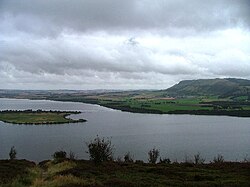Loch Leven (Kinross)
| Loch Leven | |
|---|---|

Looking north from Vane Farm
|
|
| Location | Perth and Kinross, Scotland |
| Coordinates | 56°12′01″N 3°22′47″W / 56.20019°N 3.37963°WCoordinates: 56°12′01″N 3°22′47″W / 56.20019°N 3.37963°W |
| Type | freshwater loch |
| Basin countries | Scotland |
| Max. length | 6 km (3.7 mi) |
| Islands | Loch Leven Castle |
| Designated | 5 January 1976 |
Loch Leven (from Scottish Gaelic: Loch Lìobhann) is a fresh water loch in Perth and Kinross council area, central Scotland.
Roughly triangular, the loch is about 6 km at its longest. The burgh of Kinross lies at its western end. Loch Leven Castle lies on an island a short way offshore. The castle was the prison of Mary, Queen of Scots, in 1567, and it can be reached by ferry, operated from Kinross by Historic Scotland during the summer months.
Prior to the canalisation of the River Leven, and the partial draining of the Loch in the early 19th century, Loch Leven was of considerably larger area. The fall in water level exposed several small islands, and greatly increased the size of the existing ones.
Several relics were found during the draining, one of them being a sceptre, "apparently of cane, hilted with ivory, and mounted with silver, upon which … were the letters of the words, "Mary, Queen of Scots"," found near the Mary Knowe, where she is supposed to have landed after her escape from the castle.
St Serf's Inch is the largest of Loch Leven's seven islands and it was the home of a Culdee and then an Augustinian monastic community, St Serf's Inch Priory. There was a monastic community on the island which was old in the 12th century. The monastery produced a series of Gaelic language charters from the 11th and 12th centuries which were translated into Latin in the late 12th century.
Loch Leven is a national nature reserve, as well as a Site of Special Scientific Interest and a Special Protection Area.
...
Wikipedia
